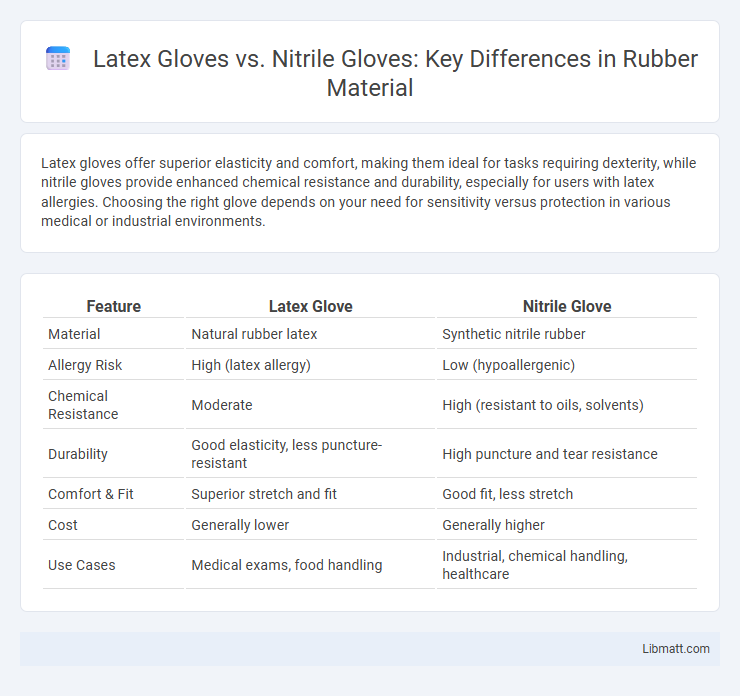Latex gloves offer superior elasticity and comfort, making them ideal for tasks requiring dexterity, while nitrile gloves provide enhanced chemical resistance and durability, especially for users with latex allergies. Choosing the right glove depends on your need for sensitivity versus protection in various medical or industrial environments.
Table of Comparison
| Feature | Latex Glove | Nitrile Glove |
|---|---|---|
| Material | Natural rubber latex | Synthetic nitrile rubber |
| Allergy Risk | High (latex allergy) | Low (hypoallergenic) |
| Chemical Resistance | Moderate | High (resistant to oils, solvents) |
| Durability | Good elasticity, less puncture-resistant | High puncture and tear resistance |
| Comfort & Fit | Superior stretch and fit | Good fit, less stretch |
| Cost | Generally lower | Generally higher |
| Use Cases | Medical exams, food handling | Industrial, chemical handling, healthcare |
Introduction to Latex and Nitrile Gloves
Latex gloves, made from natural rubber latex, offer excellent elasticity, comfort, and tactile sensitivity, making them ideal for medical and laboratory use. Nitrile gloves, composed of synthetic rubber, provide superior chemical resistance and durability, preferred in environments where exposure to oils, solvents, or chemicals is frequent. Your choice between latex and nitrile gloves depends on the need for allergen-free protection or enhanced chemical resistance in specific applications.
Material Composition: Latex vs Nitrile
Latex gloves are made from natural rubber latex, providing excellent elasticity, comfort, and biodegradability, but they may cause allergic reactions in some users. Nitrile gloves are composed of synthetic nitrile butadiene rubber, offering superior puncture resistance, chemical resistance, and hypoallergenic properties, making them ideal for users with latex sensitivities. Choosing between latex and nitrile gloves depends on your specific needs regarding material durability, allergen risk, and chemical exposure.
Key Differences in Glove Performance
Latex gloves offer superior elasticity and comfort due to their natural rubber composition, making them highly tactile and suitable for precision tasks. Nitrile gloves provide enhanced chemical resistance and puncture protection, ideal for handling hazardous substances and reducing allergy risks associated with latex proteins. While latex excels in flexibility and fit, nitrile outperforms in durability and resistance to oils, solvents, and certain chemicals.
Comfort and Fit Comparison
Latex gloves provide exceptional elasticity and a snug fit, closely mimicking the natural feel of skin which enhances dexterity and comfort during prolonged use. Nitrile gloves, while slightly less elastic, offer a more contoured fit for users with latex allergies and maintain a durable barrier that resists punctures and chemicals effectively. Your choice between latex and nitrile gloves should consider both comfort preferences and the specific protection requirements of your tasks.
Allergic Reactions: Safety Considerations
Latex gloves are known to cause allergic reactions in some individuals due to natural rubber proteins, leading to symptoms ranging from skin irritation to severe anaphylaxis. Nitrile gloves offer a safer alternative since they are made from synthetic rubber, significantly reducing the risk of allergic responses while maintaining chemical and puncture resistance. Choosing nitrile gloves is a critical safety consideration in medical and laboratory settings to protect both users and patients from latex-related hypersensitivity.
Durability and Protection Levels
Nitrile gloves offer superior durability and resistance to punctures, chemicals, and oils compared to latex gloves, making them ideal for high-risk environments. Latex gloves provide excellent elasticity and tactile sensitivity but are more prone to degradation when exposed to certain chemicals and prolonged use. Protection levels of nitrile gloves generally surpass latex due to their synthetic composition, which minimizes allergic reactions while maintaining robust barrier properties.
Cost Analysis: Latex vs Nitrile Gloves
Latex gloves generally cost less than nitrile gloves, making them a more budget-friendly option for large-scale use in medical and laboratory settings. However, nitrile gloves offer superior chemical resistance and durability, which can reduce replacement frequency and overall expenses in high-risk environments. Selecting between latex and nitrile gloves requires balancing initial cost savings with long-term performance and safety benefits.
Environmental Impact and Biodegradability
Latex gloves, derived from natural rubber latex, are biodegradable and have a lower environmental impact due to their natural composition, breaking down more quickly in composting environments. Nitrile gloves, made from synthetic rubber, are less biodegradable and contribute to long-lasting plastic waste in landfills and oceans. Choosing latex gloves can reduce your ecological footprint, especially in industries prioritizing sustainability and waste management.
Common Applications in Various Industries
Latex gloves are commonly used in healthcare, dental, and laboratory settings due to their excellent tactile sensitivity and elasticity, making them ideal for precise tasks. Nitrile gloves are favored in chemical, automotive, and food processing industries because of their superior puncture resistance and chemical durability. Both glove types serve critical roles in manufacturing and cleaning operations, ensuring safety and contamination control across diverse industrial environments.
Which Glove is Right for You?
Latex gloves offer superior elasticity and tactile sensitivity, making them ideal for medical procedures requiring precision, but may cause allergic reactions in some users. Nitrile gloves provide excellent chemical resistance and durability, suitable for handling hazardous materials or extended wear. Choose latex for tasks demanding high dexterity and nitrile for those needing enhanced protection against chemicals and punctures.
Latex Glove vs Nitrile Glove Infographic

 libmatt.com
libmatt.com